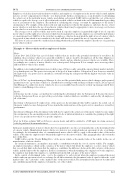Page 621 - SAIT Compendium 2016 Volume2
P. 621
IN 72 Income Tax acT: InTeRPReTaTIon noTes IN 72
Employees of dealers in new and used motor vehicles and employees of employers in the motor vehicle rental industry may use several ‘company motor vehicles’ over short periods. In these circumstances, as an alternative to determining the actual cost of the particular motor vehicle used during each period, SARS will accept that the cost of the motor vehicle is equal to the average cost of all stock in trade or rental vehicles on hand at the end of the immediately preceding year of assessment of the employer. The method of calculating the average cost must be appropriate to the dealer’s circumstances. For example, if the dealer sells new and used motor vehicles but employees only have the use of new motor vehicles or only have the use of used motor vehicles then it may be appropriate to have an average cost for new motor vehicles or an average cost for used motor vehicles.
The average cost of a motor vehicle may not be used if a speci c employee is granted the right of use of a speci c motor vehicle or if the right of use of a motor vehicle has been granted to a speci c employee as a reward for performance or a motivational tool. SARS is of the view that an employee, who has been granted the right of use of a motor vehicle for a period of time which is not considered to be short, will have been granted the use of a speci c motor vehicle.
The facts of each case must be considered in deciding whether the period that the employee has the use of a particular motor vehicle is short.
Example 6 – Motor vehicles used by employees of dealers
Facts:
Z Cars (Pty) Ltd (Z Cars) has a pool of demo vehicles that are used to take potential customers for test drives. In addition, the pool demo vehicles are generally available to and are used by all employees all the time. Employees do not have the dedicated use of a particular demo vehicle and use whichever motor vehicles are available. They accordingly use a variety of motor vehicles over a short period. Salesperson X, for example, uses on average three different motor vehicles in a month.
In addition to its standard and luxury motor vehicle range, Z Cars recently entered the superior luxury market and sells a top brand sports car. The sports car is not part of the pool of demo vehicles. Salesperson Y was, however, awarded the right of use of a sports car for a month as a reward for being the salesperson with the highest total sales value in February 2013.
One of Z Cars’ top branch managers, Manager A, does not like potential daily motor vehicle changes and is granted permission to use a pool demo vehicle for a month before rotating it with another pool demo vehicle. Z Cars agreed that Manager A could rotate motor vehicles he uses on a monthly basis because he is their top manager and Z Cars wants to retain Manager A’s services.
Result:
Z Cars may use the average cost method for calculating the determined value for Salesperson X because the motor vehicles Salesperson X uses are part of the pool of demo vehicles which are available to and used by all employees all of the time.
In relation to Salesperson Y’s right of use of the sports car, the determined value will be equal to the actual cost of the motor vehicle because Salesperson Y was awarded the dedicated use of the sports car for a month as a reward for performance.
In relation to Manager A the determined value will also be equal to the actual cost of the motor vehicle because under the circumstances the one month period is considered to be of suf cient duration to constitute the granting of the right of use of a speci c motor vehicle to a speci c employee.
Cost for Z Cars excludes VAT as Z Cars is a motor dealer and will be entitled to a VAT input tax claim on motor vehicles purchased from manufacturers.
In the past, manufacturers of motor vehicles have been permitted to use the cost of manufacture as the determined value of a motor vehicle. Manufactured motor vehicles are, however, not acquired under an agreement of sale or exchange. Accordingly, the determined value of a manufactured motor vehicle will be equal to the market value of the motor vehicle at the time the employer rst obtained the right to use the motor vehicle. This paragraph takes effect from the date of this Note.
SARS will accept the ‘Dealer Billing Price’ of the motor vehicle as the market value of the vehicle in the case of manufacturers of motor vehicles.
In certain circumstances, an employee may make a contribution towards the cost of a motor vehicle. For example, an employer may place a limit on the cost price of the motor vehicle but allows the employee to select a motor vehicle that exceeds that limit on the basis that the employee contributes the difference between the full cost price of the motor vehicle and the limit set by the employer. In these circumstances when determining ‘the original cost to the employer’, the employer may deduct the employee’s contribution from the full cost price of the motor vehicle.
In the context of determined value, ‘cost to the employer’ is only relevant when the employer acquired the motor vehicle under an agreement of sale or exchange. In all other situations, the determined value is equal to either the ‘retail market value’, the ‘cash value’ or the ‘market value’ of the motor vehicle. The determined value may not be reduced by any contribution paid by the employee towards the cost of the vehicle.
saIT comPendIum oF Tax LegIsLaTIon VoLume 2 613


